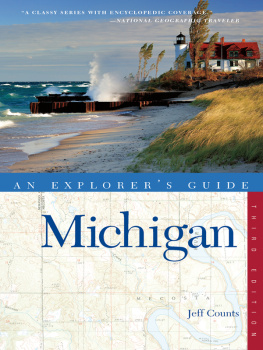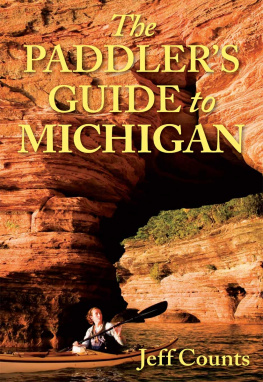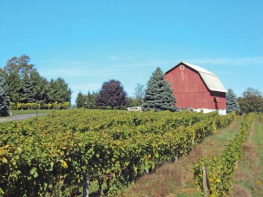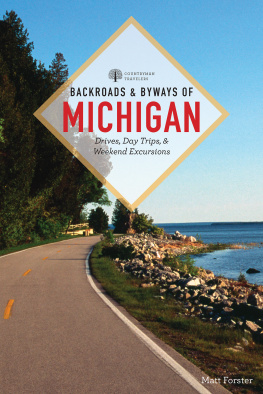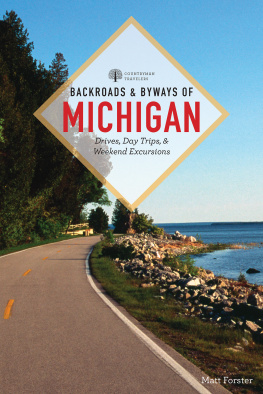
We find after years of struggle that we do not take a trip; a trip takes us.
John Steinbeck, Travels with Charley
EXPLORE WITH US!
Welcome to the third edition of the most comprehensive guide to Michigan. Its the perfect companion for exploring both the Upper and Lower Peninsulas and shorelines along Lakes Michigan, Huron, and Superior. I have tried to select the best places, but have included many lodging establishments and restaurants simply because theyre your only options in some parts of the state. The selections are based on my personal experiences and on those of a cadre of friends and business associatesnot on paid advertising. Like other Explorers Guides, this book is a classic travelers guide, with a clear, easy-to-use layout. Sidebars mark the authors personal favorites in each chaptera subjective selection, but good guidance when you only have a day or so to spend in an area. (Please e-mail me at if you have any specific questions or comments about the information provided herein. You can also get regular updates about Michigan travel on my Facebook page, Michigan: An Explorers Guide .)
WHATS WHERE
In the beginning of the book there is an alphabetical listing of local information and highlights of the state that you can quickly reference. Youll find advice on everything from Yooper culture to where the best beaches are.
LODGING
Please dont hold the publisher or the respective innkeepers responsible for the rates listed here. Changes are inevitable. Taxes on rooms vary throughout the state, with many communities imposing their own.
Lodging price codes:
$: Up to $75 per couple
$$: $76150 per couple
$$$: $151250 per couple
$$$$: More than $250 per couple
RESTAURANTS
In most sections, there is a distinction between Dining Out and Eating Out. Restaurants listed under Eating Out are generally inexpensive and more casual; reservations are often suggested for restaurants in Dining Out.
Dining price codes:
$: Up to $10
$$: $1125
$$$: $2640
$$$$: More than $40
SMOKING
Smoking has been banned in restaurants, taverns, and hotels/motels.
KEY TO SYMBOLS

| Child friendly. The crayon denotes a family-friendly place or event that welcomes young children. Many B&Bs dont cater to children under 12. |

| Handicapped access. The wheelchair icon denotes a place with full Americans with Disabilities Act (ADA) standard access, still distressingly rare in many remote areas. |

| Rainy day. The umbrella icon points out places where you can entertain yourself, and stay dry, in bad weather. |

| Pets. The dogs paw icon identifies lodgings that allow pets, still an exception to the rule. Accommodations that accept pets may charge an extra fee or restrict pets to certain areas, as well as require advance notice. |

| Wedding friendly. The wedding rings icon denotes places and establishments that are good venues for weddings. |

| Liquor. The martini glass icon denotes taverns, bars, and restaurants where alcohol is served. |
CONTENTS
MAPS
W elcome to the third edition of this book, which will help you discover everything from hidden gems in Detroits entertainment district to remote backwoods taverns in Michigans sparsely populated Upper Peninsula. Along the way, youll be introduced to the states 2,288 miles of Great Lakes coastline, thousands of inland lakes, and just as many miles of rivers and streams, all fraught with possibilities for recreation and leisure travel.
For me, the book is an ongoing project, as Im constantly on the road in Michigan in my Jeep fishing, hunting, paddling my kayak, or hanging out in the Detroit area. My most recent projects for The Countryman Press have been The Paddlers Guide to Michigan and Detroit/Ann Arbor: A Great Destination , both of which work hand in glove with this guide.
I hope the guide helps you explore a state too often known for its rust belt image than for its stunning views of the Great Lakes and tremendous opportunities for fishing, backpacking, hiking, kayaking, and swimming.
In the past several years there have been many changes, some wrought by the economy and others by changing tastes and styles. Many upscale restaurants have closed or have switched to more casual formats. Brewpubs with their local beers are now more common than fine dining establishments.
Grand Rapids in western Michigan has become a hot spot for brewpubs and such establishments in the up-and-coming midtown area of Detroit are attracting attention.
Many newer restaurants are stressing that they use local, fresh ingredients and thats also influenced food choices. Because of that, many farmers markets are listed in the guide.
Detroit is often in the headlines, and not always for good things. But the auto industry is on the upswing and there are good things happening in Motown. Midtown, with its proliferation of loft apartments, is attracting new, younger residents, and even a Whole Foods store. More hotels are opening in the downtown area, and the guide offers a beefed-up chapter on the city.
Even Michigan residents and native Detroiters will find something new in this guide.
The guide is divided into generally accepted regions, with each section containing a brief description of the area, a short look at its history, and what there is to do. There are three distinct regions in the state, the southern portion, which is filled with cities; northern Michigan, with its lakes, where people vacation; and the Upper Peninsula, which is almost a state unto itself. I have included many of the areas in those regions, but not all, as Ive tried to stick with the areas that are of the most interest to travelers.
Michigan is a diverse state that ranges from heavily populated in the southern portion, to sparsely in portions of the Upper Peninsula. There are assembly lines in the south, and wolf and moose roam the Upper Peninsula. I critique upscale restaurants (Dining Out) and everyday options (Eating Out), plus North Woods taverns, bakeries, and even grocery stores in rustic areas where the eating options are limited. Except for along the Lake Michigan coast, and in the urban areas of southern Michigan, you wont find many topnotch restaurants, but I have listed the best I found.
I describe many of the states inns, B&Bs, and family-owned motels, and in some cases have broken with the Explorers Guide tradition and listed chain hotels and motels because there are few other options in certain areas. I also included many housekeeping cabins and cottages sought after by anglers, hunters, bicyclists and winter-sports enthusiasts.
In-state travel accounts for about 75 percent of the states tourism, and heading to the family cottage or favorite campground is part of the Michigan lifestyle, which includes hunting for deer, bear, woodcock, and grouse during fall and snowmobiling, and downhill and cross-country skiing in winter. Except for steelhead anglers, most folks stay home during the muddy months of March and April.
Next page
